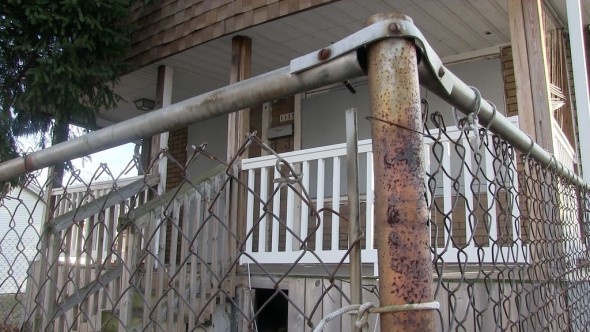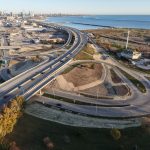Clarke Square
On just one block of W. Mineral St., the homes lost 43 percent of their value. Overcoming the foreclosure problem is a slow process.
Bernardo Gonzalez has lived at 1127A W. Mineral St. in the Clarke Square neighborhood for seven years. For his first six years on the block, there was a large home located between his property and the street. That changed about a year ago, when the owner deserted the property and the city demolished the home, Gonzalez said.
“It was a nice house, but the owner didn’t want it anymore,” he said.
The city foreclosed on the property due to back taxes, taking ownership of the vacant lot in September.
On the 1100 block of W. Mineral St., there are 14 properties, including the vacant lot in front of Gonzalez’s home and a vacant lot just four doors down. The house on that lot was demolished in November 2012. The block also has one foreclosed house and another home that is heading in that direction.
All four of the struggling properties are located on the south side of the street, while the north side has been relatively unaffected. The average assessed value of the property on the south side of the street is nearly $40,000 less than on the north side.

The sign on the lawn of 1119 W. Mineral St. makes it clear that the city has demolished this property and wants the public to steer clear.
The city is forced to demolish vacant foreclosed homes because they quickly become popular spots for squatters once the original owners leave, said District 12 Alderman Jose Perez.
“We get phone calls that someone was in the property that was boarded up,” he said. “Either they broke in to do nuisance behavior, or to steal any scraps to get some money out of it. And that provided an eyesore.”
The problem is manifesting itself for a third time, this time at 1115 W. Mineral St., a house that has been abandoned and boarded up for at least five months, according to Rusthman Martinez, who lives on the block.
Perez said that the owner of that property, Isidro Maldonado, died in 2003 and his family took care of the home until deserting it in 2007.
“It’s not clear from the city records what happened to (the property) after his death,” he said. “It wasn’t a mortgage foreclosure and it wasn’t anything against him or his estate but their heirs, whoever, might have just walked away from the property.”
According to Perez, since the owners abandoned the property, the city began noticing that property taxes were not being paid. Last month the city officially took ownership. Perez said the amount of time that the city waits before taking over a property varies.
“We could do it sooner, but usually when you’re already two years behind and there’s no communication, no interaction about paying your property taxes, then in the third year, they’ll start the process,” he said.
Gonzalez and his neighbors are concerned that more vacant properties on the block will hurt already-declining property values. Since 2008, homes on the block have lost 43 percent of their value. Milwaukee as a whole has lost 26 percent of its housing value in that time span, according to Milwaukee Housing Director Aaron Szopinski.
Gonzalez, who has construction skills, said he would like to purchase the property at 1115 W. Mineral St. and fix it up himself. One way the city has been able to turn foreclosed homes over to new owners is through a weekly auction, according to Szopinski.
“You can go to the courthouse any Monday,” Szopinski said. “You sit down and watch people put cash on the barrelhead for homes. You could bid a dollar and win a house and it’s yours. You’ll have to then take the deed and record it and … you become the owner.”
Gonzalez seems like a good candidate for ownership. He recently had to replace the siding on his own home, but did not want to pay a contractor $5,000 to do the job. Instead, he spent $2,000 on the materials and did it himself. Gonzalez said if he could get a good deal on the house at 1115 W. Mineral St., he would be willing to invest his own time and money to repair the roof and windows and flip the home for a profit.
“It wouldn’t take long to fix that up,” he said. “I bet I can fix it in six months.”
Unfortunately, this is often easier said than done, as much of the damage to a vacant home can not be seen from the outside. When homes sit vacant for months or, in some cases, years, they attract some people who are looking for more than just a roof to sleep under. Common Council President Michael Murphy said homes could be stripped of their copper wiring, leaded glass or other valuable architectural items within weeks of being deserted.
When this happens, Murphy said it’s often not worth rehabbing the home, since the amount of money required to fix it up is actually more than the value of the home.
Sometimes demolition is just an unfortunate inevitability, Szopinski said.
“When you have people walking away in big numbers and in big ways, it has a real cost and people don’t see it directly but they see it indirectly,” he said. “They see vacancy and abandonment on the block. They see increased crime. They feel unsafe, even if the crime doesn’t go up because that house is sitting there boarded. Who knows what’s going to happen? It’s very uncertain. Demolition is one thing that we do, and we all hate to do it.”
Tale of two sides of the same street
An analysis of property values on the two sides of the 1100 block of W, Mineral St. in the Clarke Square neighborhood illustrates the effect of demolition on surrounding property values.
Buildings on both sides of the block are more than a century old. Most were built between 1880 and 1900, and the newest house was built in 1929, presumably before the devastating stock market crash in late October that year.
On the north side of the block, which has five lots, sit homes that appear relatively upscale for the neighborhood. The house at 1102 W. Mineral St. features 2,056 square feet of living space, a 440-square-foot garage and a sizeable side yard. A four-unit apartment building is the most valuable property on the block.
The south side of the block, with nine lots, tells a completely different story. Two properties on that side of the street have been demolished, one in 2012 and the other within the past year. Only one property on the south side has a higher 2014 assessed value than any property on the north half.
The 1100 block was hit especially hard by the recession in 2008. Before the housing bubble burst and the economy crashed, the homes on the 1100 block had a combined assessed value of $934,700. In six years, the block’s properties lost 43 percent of their value, and are now worth a combined $533,100. Overall, Milwaukee lost 26 percent of its housing value since the recession began, according to Milwaukee Housing Director Aaron Szopinski.
Even in the past year, when property values in the city as a whole were beginning to recover, the block’s assessed value decreased, losing $60,700 from 2013 to 2014. The main reason for the drop was the demolition of 1127 W. Mineral, which lost 90 percent of its value after the owner failed to pay taxes or cooperate with city-mandated upkeep, according to a neighbor, Bernardo Gonzalez. It is now worth $3,200, according to data published by the Milwaukee County assessor’s office.
The other demolished home on the block, 1119 W. Mineral, was worth $83,800 in 2008. In 2012 it was demolished by the city.
Even with four fewer properties, the north side accounts for about 60 percent of the block’s 2014 assessed value, with five of the six most valuable properties on the block.
Including the now-demolished homes, the properties in the 1100 block are worth, on average, $38,058. The five homes on the north side average $63,840 in assessed value, while the south side’s nine properties average $23,766. The homes on the south side account for 99 percent of delinquent property taxes homeowners on the block owe the city.
Why this discrepancy?
The demolished homes diminish the average value on the south side of the block. The seven standing homes on the south side lost an average of 4.5 percent of their assessed value in the past year, when 1127 W. Mineral St. was demolished.
Szopinski said that in a lot of cases, demolition of deteriorated homes is a good solution. He said when he asks neighbors how they feel about demolitions, they generally say something like, “they’ve been gone so long and enough bad stuff has happened around that place that I’d rather have it gone.”
Still, between the boarded-up houses, the foreclosed property at 1115 W. Mineral St., a prime candidate for demolition, and 1125 W. Mineral heading in that direction, more torn-down houses might make an already-struggling block derelict.
Political Contributions Tracker
Displaying political contributions between people mentioned in this story. Learn more.
- March 28, 2016 - Michael Murphy received $25 from Aaron Szopinski
Foreclosures Block By Block
-
Layton Boulevard West
 Jan 8th, 2015 by Matt Barbato and Aaron Maybin
Jan 8th, 2015 by Matt Barbato and Aaron Maybin
-
Five Neighborhoods With Foreclosure Problems
 Jan 7th, 2015 by Matthew Wisla
Jan 7th, 2015 by Matthew Wisla






















Using 2008 “values” is not a smart benchmark. Those numbers were inflated by anywhere between 10% and 30% and exposes a huge weakness when City Assessments track the market (they should not). Assessments should only change when a house is sold and someone inspects/valuates, the interior and exterior of residence. Not sure why Milwaukee has not developed a better system. But the difference between a 43% drop and a 26% has a lot more to do with the former being hyper-inflated and the latter being a warning to never let lower income neighborhoods get stuck in a price bubble war with other neighborhoods. Instead of masking tax rates with pumped up assessments, the City should learn from history and not tax parcels for being in a “zone” where housing prices are going up…government inadvertently made the bubble bigger and the burst more of a painful crash
Thanks to the journalists and Milwaukee NNS for shedding light on this challenge to the city and near South Side in particular with this series. I offer up a minor clarification. Even though Clarke Square (between Cesar Chavez Drive on the East, Layton Boulevard on the West and Pierce/Mitchell Park on the North and Greenfield on the South) has its share of tax and traditional bank foreclosures, the 1100 block of Mineral isn’t within our neighborhood’s boundaries. Being immediately West of Walker’s Square, however, we feel the effects of the challenges there and stand committed to working with nearby neighborhoods, the City and other partners to assure a stable and high quality housing market throughout the South Side. Again, thanks for shining light on this challenge and some of the work happening to mitigate it.